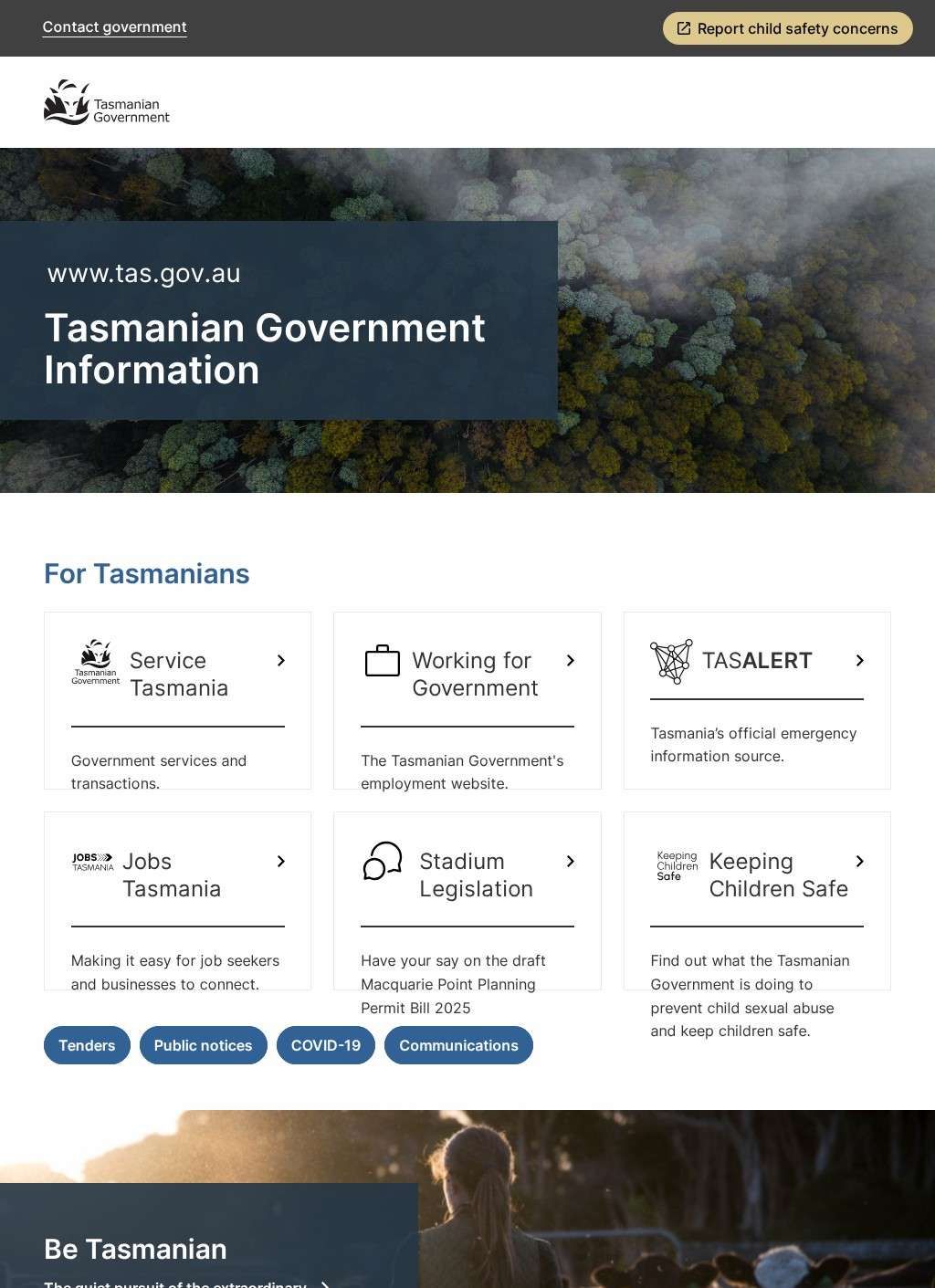The Tasmanian Government website serves as the primary digital interface between Tasmania's state government and its citizens, operating within Australia's Westminster system while addressing the unique challenges and opportunities of governing an island state. Tasmania's governmental structure reflects its status as Australia's smallest state by population but one with distinct geographic, economic, and cultural characteristics that require specialized policy approaches. The website organizes extensive government services and information in ways that acknowledge both the intimate scale of Tasmanian politics and the complex relationships between state government, local councils, and Commonwealth responsibilities.
The platform's architecture reflects Tasmania's distinctive demographics and geography, with services organized around the realities of governing a population of approximately 540,000 people distributed across urban centers, rural communities, and remote regions. Unlike larger Australian states where government services might feel impersonal, the Tasmanian Government website maintains an accessibility and responsiveness that reflects the state's more intimate political culture. Citizens often have more direct access to senior government officials and policy-making processes than their mainland counterparts, a reality reflected in the website's community engagement features.
Economic development services occupy substantial digital real estate, reflecting Tasmania's ongoing efforts to diversify beyond traditional industries like forestry, mining, and agriculture. The website provides information about business development programs, export assistance, and innovation initiatives designed to support emerging sectors like renewable energy, aquaculture, and advanced manufacturing. Tasmania's position as a renewable energy leader shows up in dedicated resources about hydroelectric power, wind energy, and emerging technologies that leverage the state's natural advantages.
Environmental and natural resource management receives extensive coverage, reflecting both Tasmania's natural heritage and its economic dependence on primary industries. The website includes information about World Heritage area management, sustainable forestry practices, and marine resource protection. Tasmania's complex relationship with environmental conservation - balancing economic needs with preservation of unique ecosystems - appears throughout policy documents and consultation processes. Climate change adaptation receives particular attention given Tasmania's vulnerability to sea level rise and changing weather patterns.
Health services information acknowledges the unique challenges of delivering medical care across an island state with dispersed populations and limited specialist resources. The website includes information about Royal Hobart Hospital, regional health centers, and coordination with mainland facilities for specialized treatment. Mental health services receive prominent coverage, recognizing both the challenges of rural isolation and the opportunities for community-based support networks that smaller populations can provide.
Education services cover the full spectrum from early childhood programs to tertiary education partnerships, with particular attention to the role of the University of Tasmania in state development. The website provides information about student transport services essential for rural families, Distance education programs, and vocational training aligned with state economic priorities. Adult education and retraining programs address workforce development needs as traditional industries evolve.
Emergency services coordination reflects Tasmania's exposure to natural disasters including bushfires, flooding, and severe weather events that can isolate communities and disrupt essential services. The website includes current warning systems, preparedness information, and response protocols tailored to Tasmanian conditions. The state's small size enables more integrated emergency response but also means that major events can affect larger proportions of the population and infrastructure.
Transport and infrastructure information covers both internal connectivity and external links essential for an island economy. The website includes information about road maintenance across often challenging terrain, public transport services in urban areas, and coordination with ferry and air services that connect Tasmania to mainland Australia. Infrastructure development projects often carry strategic importance disproportionate to their size, making project information and consultation processes particularly significant.
Cultural and heritage services reflect Tasmania's unique position in Australian history and its contemporary cultural renaissance. The website includes information about heritage site protection, arts funding programs, and cultural institutions that showcase both Aboriginal heritage and convict history. Tasmania's growing reputation as a cultural destination shows up in government support for festivals, museums, and creative industries that contribute to both cultural identity and economic development.
Community services address both urban needs and the particular challenges of supporting remote and rural populations. The website includes information about aged care services, disability support, and child protection programs that must operate across vast distances with limited resources. Indigenous affairs receive dedicated attention, recognizing the state's Aboriginal communities and ongoing reconciliation efforts.
The website includes comprehensive contact information organized by department and service area, with recognition that many Tasmanians prefer phone contact over digital services. Regional service centers provide local access points while maintaining connections to central administrative systems in Hobart. Online services continue expanding but acknowledge that digital literacy and internet access vary significantly across the state's diverse communities.
Democratic participation features include detailed information about state elections, parliamentary processes, and public consultation opportunities. The website provides access to parliamentary proceedings, government reports, and policy development processes that often involve more direct citizen participation than larger jurisdictions can accommodate. This transparency reflects both democratic tradition and the practical reality that government decisions in a small state often have more direct and visible impacts on citizens' daily lives.
